|
||||||
|
SOLIDAGO. Golden Rods. [Asteraceae] |
|
|
Twelve species of Solidago are recorded in Britain. These include the native Goldenrod (S. virgaurea) and eleven introduced Goldenrods including Canadian Goldenrod (S. canadensis) and Early Goldenrod (S. gigantea). Fifteen British miners are recorded on Solidago. Coleophora obscenella is recorded feeding on seeds of Solidago virgaurea and occasionally on Aster tripolium (see British leafminers). A key to the European miners recorded on Solidago is provided in Bladmineerders van Europa. |
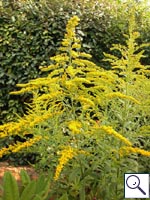 Goldenrod Solidago virgaurea |
Key for the identification of the known mines of British |
||
Note: Diptera larvae may live in a corridor mine, a corridor-blotch mine, or a blotch mine, but never in a case, a rolled or folded leaf, a tentiform mine or sandwiched between two more or less circular leaf sections in later instars. Pupation never in a cocoon. All mining Diptera larvae are leg-less maggots without a head capsule (see examples). They never have thoracic or abdominal legs. They do not have chewing mouthparts, although they do have a characteristic cephalo-pharyngeal skeleton (see examples), usually visible internally through the body wall. The larvae lie on their sides within the mine and use their pick-like mouthparts to feed on plant tissue. In some corridor miners frass may lie in two rows on alternate sides of the mine. In order to vacate the mine the fully grown larva cuts an exit slit, which is usually semi-circular (see Liriomyza huidobrensis video). The pupa is formed within the hardened last larval skin or puparium and as a result sheaths enclosing head appendages, wings and legs are not visible externally (see examples). See Key to non-Diptera. |
||
1# > ? Leaf-miner: Details of mine unknown. |
||
|
||
Pegomya depressiventris (Zetterstedt, 1845) [Diptera: Anthomyiidae] |
||
1a > Stem-miner: External stem-miner (Spencer, 1972b: 61). |
||
|
||
Phytoliriomyza arctica (Lundbeck, 1901) [Diptera: Agromyzidae]. |
||
1a >Stem-miner: A narrow, inconspicuous stem mine. Pupation at the end of the mine (Spencer, 1976: 64). Fine, upper- or lower-surface corridor, ending in a thick vein. From there the mine extends finally to the rind of the stem. There also the pupation takes place, usually not far from the root collar. Mines in the stem rind often are conspicuous through a red discoloration. |
||
|
||
Ophiomyia curvipalpis (Zetterstedt, 1848) [Diptera: Agromyzidae]. |
||
1b > Leaf-miner: A distinctive mine primarily above mid-rib, with irregular short lateral offshoots into leaf blade. Pupation external (Spencer, 1972: 51 (fig. 172), 55; Spencer, 1976: 270, 271 (fig. 486)). Branched, whitish, upper-surface corridor; main axis overlying the midrib; side branches overlying the main lateral veins. (In Campanula and Phyteuma the mine is much less branched, sometimes nothing more than a corridor on top of the midrib). Frass in rather long strings. Usually the mines begins as a long and narrow, shallow, tortuous lower-surface corridor that ends upon the midrib but otherwise is not associated with the leaf venation. Often this initial corridor is filled with callus, and then even less conspicuous. Pupation outside the mine. A linear mine on the upper surface, usually following the midrib and showing side branches along the veins. The frass is in strings. |
||
|
||
|
||
Liriomyza strigata (Meigen, 1830) [Diptera: Agromyzidae]. |
||
1c > Leaf-miner: Mine not primarily associated with the mid-rib. |
||
2a > Leaf-miner: A linear mine commencing with a conspicuous regular spiral and then continuing a considerable distance more or less straight (Spencer, 1976: 245). Upper-surface corridor. The first part is wound in a dense spiral that quickly turns brown. The spiral continues in a long, generally unbranched corridor that maintains almost the same width. Frass in long thick strings. When the mine is positioned near the leaf margin the spiral part may be missing; the thick frass strings then are sufficiently characteristic. Pupation outside the mine; exit slit in lower epidermis. Long upper surface gallery starting with a spiral of 6 to 8 turns (as shown). Frass in conspicuous narrow linear lines. |
||
|
||
Liriomyza eupatorii (Kaltenbach, 1873) [Diptera: Agromyzidae]. |
||
2b > Leaf-miner: An irregular linear mine, which in small leaves can form a secondary blotch. Long, upper-surface corridor, winding through the leaf and frequently crossing itself; in small leaves often a secondary blotch in the end. Frass in short strings and pearl chains. Pupation outside the mine. An irregular gallery, sometimes crossing over, with black frass arranged as elongate very narrow streaks at the sides of the mine. |
||
|
||
Liriomyza pusilla (Meigen, 1830) [Diptera: Agromyzidae]. |
||
2c > Leaf-miner: Broad corridor overlying the midrib. The mine has a number of side branches that distally widen strongly, and may coalesce. Primary and secondary feeding lines very conspicuous. Pupation external, in soil. |
||
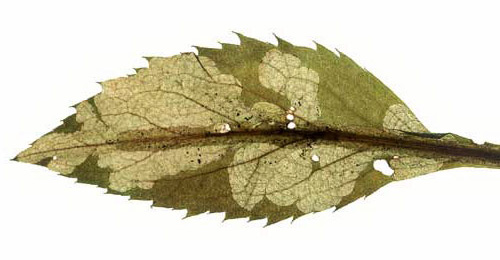 Mine of Cornutrypeta spinifrons on Senecio ovalis Image: © Willem Ellis (Bladmineerders van Europa) |
||
|
||
Cornutrypeta spinifrons (Schroeder, 1913) [Diptera: Tephritidae]. |
||
2d > Leaf-miner: A large, brownish blotch, with conspicuous feeding lines. Pupation external (Spencer, 1972b: 62 (fig. 205), 63; Spencer, 1976: 308, 309 (fig. 557)). Large, brown, upper-surface blotch with conspicuous primary and secondary feeding lines. The feeding lines are the more apparent because the semiliquid frass adheres to them. Pupation outside the mine; exit slit in the upper epidermis. A short broad gallery, normally at the margin, leading to a blotch with obvious feeding lines in whorls. Mines go brown. |
||
|
||
Nemorimyza posticata (Meigen, 1830) [Diptera: Agromyzidae]. |
||
2e > Leaf-miner: A long, winding leaf-mine on the upper surface of the leaf, with frass widely-spaced in conspicuous black lumps. Pupation internal, at the end of mine (Spencer, 1972b: 28 (fig. 68), 29). |
||
|
||
Ophiomyia maura (Meigen, 1838) [Diptera: Agromyzidae]. |
||
2g > Leaf-miner: A conspicuous white mine with frass in more or less connected strips, older mines can show a conspicuous reddish-violet discolouration (Spencer, 1972b: 76 (fig. 253), 80; Spencer, 1976: 501). Upper surface corridor, 6-9 cm in length, densely wound, easily confluent into a secondary blotch. Frass unusual, in more or less connected strings at either side of the corridor. Pupation outside the mine, exit slit usually in the upper epidermis. According to Hering dried mines turn yellow brown to reddish purple. |
||
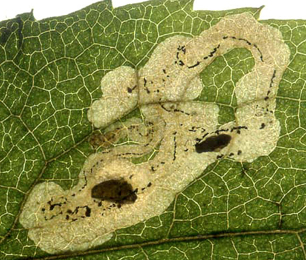 Mine of Phytomyza solidaginis on Solidago virgaurea Image: © Willem Ellis (Bladmineerders van Europa) |
||
|
||
Phytomyza solidaginis Hendel, 1920 [Diptera: Agromyzidae]. |
||
2h > Leaf-miner: A whitish linear mine, with frass predominantly in separate grains, rather than connected strips (Spencer, 1976: 525). Initially narrow, gradually and weakly widening corridor of about 10-12 cm. The mine is upper-surface, pale green. Feeding lines not conspicuous. Frass in separate grains or short pearl chains. Pupation outside the mine, exit slit in lower epidermis. |
||
|
||
Phytomyza virgaureae Hering, 1826 [Diptera: Agromyzidae]. |
||
| 2i > Leaf-miner: The pale-coloured mine runs on the upper side irregularly to the sides, in the middle with blackish spots, where the frass is deposited. It starts in the center of a leaf and without a small mine leading to a large mine. Many mines in a leaf could finally cover the whole leaf. | ||
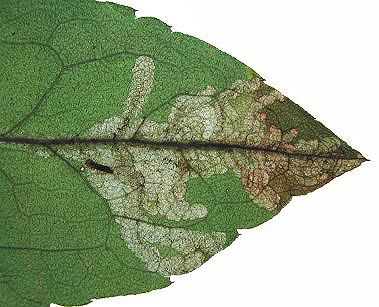 Mine of Pegomya nigrisquama Image: © Rob Edmunds (British leafminers) |
||
|
||
Pegomya nigrisquama (Stein, 1888) [Diptera: Anthomyiidae]. |
||
2j > Leaf-miner: A short linear mine in first instar, later producing a circular or oval blotch. Frass is excreted in a black mass prior to pupation; puparium firmly glued with frass within the mine (Spencer, 1976: 306). Large, whitish, upper-surface blotch, preceded by a short corridor that often is overrun later by the developing blotch. The larva hardly produces any frass; the few grains that are present are black and rather coarse. But when the larva is about to pupate, it empties its intestine, which has the effect that the puparium is anchored in the mine by dried frass. The initial gallery by the first instar larva then leads to a whitish blotch. The puparium is fixed to the inside of the mine by an accumulation of frass. |
||
|
||
Calycomyza humeralis (von Roser, 1840) [Diptera: Agromyzidae]. |
||
|
Key for the identification of the known mines of British |
Note: The larvae of mining Coleoptera, Hymenoptera and Lepidoptera may live in a corridor mine, a corridor-blotch mine, a blotch mine, a case, a rolled or folded leaf, a tentiform mine or sandwiched between two more or less circular leaf sections in later instars. Larva may pupate in a silk cocoon. The larva may have six legs (although they may be reduced or absent), a head capsule and chewing mouthparts with opposable mandibles (see video of a gracillarid larva feeding). Larvae of Hymenoptera and Lepidoptera usually also have abdominal legs (see examples). Frass, if present, never in two rows. Unless feeding externally from within a case the larva usually vacates the mine by chewing an exit hole. Pupa with visible head appendages, wings and legs which lie in sheaths (see examples). |
| 1a > Leaf-miner and case-bearer: Tubular silk case, about 9 mm long, trivalved, with a mouth angle of about 20°. |
|
Coleophora ramosella Zeller, 1849 [Lepidoptera: Coleophoridae]. |
1b > Leaf-mine, but not a case-bearer: The mine begins in the midrib, especially in a lower leaf, extending into the leaf disc, branching irregularly or pinnately, may also locally be blotch like. The mine is brown and very transparent. Sides very irregularly eaten out. Frass loosely dispersed or in a loose central line, buy may also be pressed against the sides of the corridor. The larva may also leave the mine and restart elsewhere. |
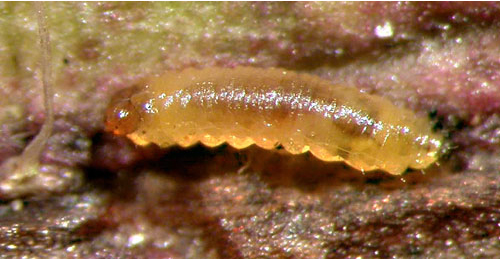 Orthochaetes setiger larva, dorsal Image: © Jean-Yves Baugnée (Bladmineerders van Europa) |
|
Orthochaetes setiger (Beck, 1817) [Coleoptera: Curculionidae]. |
| Last updated 09-Jul-2020 Brian Pitkin | ||

